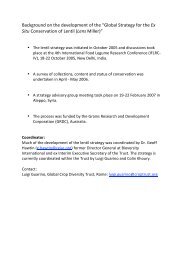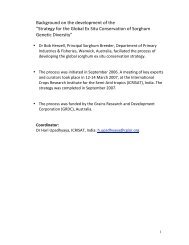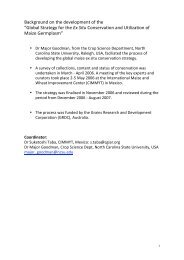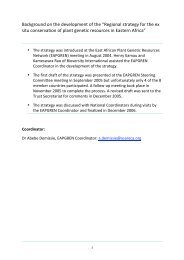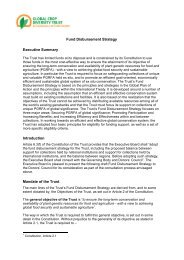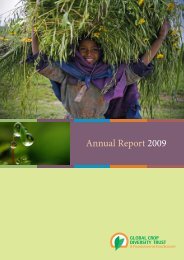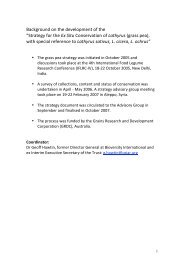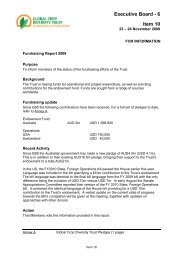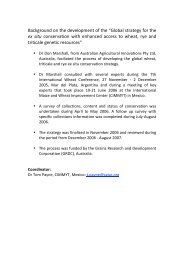Global Strategy for the Ex Situ Conservation of Potato - Global Crop ...
Global Strategy for the Ex Situ Conservation of Potato - Global Crop ...
Global Strategy for the Ex Situ Conservation of Potato - Global Crop ...
You also want an ePaper? Increase the reach of your titles
YUMPU automatically turns print PDFs into web optimized ePapers that Google loves.
<strong>of</strong> germplasm effectively. As can be noticed from Table 2, some <strong>of</strong> <strong>the</strong> genebanks listed in<br />
Table 3 have indicated that <strong>the</strong>ir storage facilities are not up to standards.<br />
Not included are seven collections, which conserve limited, rarely unique germplasm. The<br />
scoring is based on <strong>the</strong> in<strong>for</strong>mation <strong>of</strong> <strong>the</strong> questionnaire and <strong>the</strong> judgement <strong>of</strong> <strong>the</strong> consultant.<br />
Annex 9 presents a ranking <strong>of</strong> <strong>the</strong> quality <strong>of</strong> per<strong>for</strong>mance <strong>of</strong> eight genebank functions in 16<br />
relevant potato genebanks. Genebanks are listed in decreasing order <strong>of</strong> perceived quality <strong>of</strong><br />
per<strong>for</strong>mance <strong>of</strong> genebank functions. To arrive at such estimate, each genebank function has<br />
been given <strong>the</strong> same weight.<br />
It can be concluded that a group <strong>of</strong> ten genebanks per<strong>for</strong>m <strong>the</strong> eight major genebank<br />
functions concerned generally well, whereas <strong>the</strong> lower six collections exhibit constraints in<br />
<strong>the</strong>ir per<strong>for</strong>mance.<br />
7.4 An analysis <strong>of</strong> <strong>the</strong> capacity <strong>of</strong> potato genebanks to meet eligibility principles<br />
A number <strong>of</strong> countries hosting collections that have been given high priority <strong>for</strong> support have<br />
not yet signed or ratified <strong>the</strong> International Treaty (Annex 8). In such cases, conditions <strong>for</strong><br />
access and benefit sharing <strong>of</strong> PGRFA which conservation is to be supported by <strong>the</strong> Trust still<br />
need to be clarified and agreed. Institutions in countries which do not meet <strong>the</strong> Trust’s<br />
eligibility criteria with regard to <strong>the</strong> International Treaty <strong>of</strong> PGRFA, may be requested to sign<br />
<strong>the</strong> “Solemn Undertaking <strong>for</strong> access or conservation” in stead (Annex 10a and b).<br />
8. Process <strong>for</strong> <strong>the</strong> implementation <strong>of</strong> <strong>the</strong> strategy<br />
In chapter 7, two different options <strong>for</strong> Trust support, i.e. <strong>the</strong> funding <strong>of</strong> collaborative projects<br />
involving participation <strong>of</strong> several genebanks, and capacity building and upgrading <strong>of</strong><br />
individual genebanks have been proposed.<br />
8.1 Collaborative project implementation<br />
The participants in <strong>the</strong> Lima workshop agreed to establish a Consortium that can be<br />
consulted by <strong>the</strong> Trust and that, at <strong>the</strong> request <strong>of</strong> <strong>the</strong> Trust, might oversee <strong>the</strong><br />
implementation <strong>of</strong> a potato conservation strategy. The activities <strong>of</strong> <strong>the</strong> Association <strong>of</strong> <strong>Potato</strong><br />
Inter-genebank Collaborators (APIC) conducted from 1990 to 2002 were much appreciated<br />
by <strong>the</strong> participants in <strong>the</strong> Lima workshop, and it was accepted that <strong>the</strong> newly established<br />
Consortium should take over <strong>the</strong> role <strong>of</strong> APIC as a global potato conservation group.<br />
At <strong>the</strong> request <strong>of</strong> <strong>the</strong> Trust, <strong>the</strong> Consortium could also oversee a process <strong>for</strong> <strong>the</strong> fur<strong>the</strong>r<br />
development <strong>of</strong> pre-proposals based on <strong>the</strong> priorities outlined above. The three prioritised<br />
pre-proposals (see 7.2) need to be fur<strong>the</strong>r elaborated, and <strong>for</strong> this purpose an advisory<br />
group was appointed consisting <strong>of</strong> <strong>the</strong> focal persons <strong>of</strong> <strong>the</strong> originaly suggested five projects<br />
and additional advisors. The following arrangements were made in <strong>the</strong> Lima workshop:<br />
I. Focal persons <strong>for</strong> <strong>the</strong> five pre-proposals were identified:<br />
! Documentation (1); Reinhard Simon (CIP) and Roel Hoekstra (CGN)<br />
! Regeneration (2); Andrea Clausen (INTA)<br />
! Health screening (3); Enrique Chuioy (CIP)<br />
! <strong>Conservation</strong> Standards (4); A. Panta (CIP) and Ximena Cadima (PROINPA)<br />
! Rationalisation: Carlos Arbizu (CIP)<br />
•<br />
II. The advisory group was established, and <strong>the</strong> following members were agreed:<br />
! Seven focal persons (see II)<br />
! John Bamberg (USDA-ARS/ NP6)<br />
! Gavin Ramsey (CPC)<br />
25




